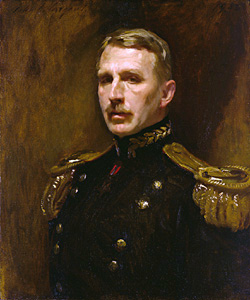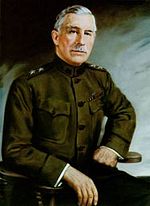
Leonard Wood (October 9, 1860 – August 7, 1927) was a physician who served as the US Army Chief of Staff and Governor General of the Philippines. He later became a recipient of the Medal of Honor.
Early life and career
Born in Winchester, New Hampshire, he attended Pierce Academy in Middleborough, Massachusetts, and Harvard Medical School, earning an M.D. degree in 1884 as an intern at Boston City Hospital.
He took a position as an Army contract physician in 1885, and was stationed at Fort Huachuca, Arizona. Wood participated in the last campaign against Geronimo in 1886, and was awarded the Medal of Honor in 1898 for carrying dispatches 100 miles through hostile territory and for commanding an infantry detachment whose officers had been lost.
Wood was personal physician to Presidents Grover Cleveland and William McKinley through 1898. It was during this period he developed a friendship with Theodore Roosevelt, then assistant secretary of the Navy.
Spanish-American War

At the outbreak of the Spanish-American War, Wood, with Roosevelt, organized the 1st Volunteer Cavalry regiment, popularly known as the Rough Riders. Wood commanded the regiment in a successful engagement known as the Battle of Las Guasimas. When brigade commander, Samuel B. M. Young became ill, Wood received a field promotion to brigadier general of volunteers and assumed command of the 2nd Brigade, Cavalry Division, V Corps (which included the Rough Riders) and led the brigade to a famous victory at Kettle Hill and San Juan Heights.
After San Juan, Wood led the 2nd Cavalry Brigade for the rest of the war; he stayed in Cuba after the war and was appointed the Military Governor of Santiago in 1898, and of Cuba from 1899–1902. In that capacity, he relied on his medical experience to institute improvements to the medical and sanitary conditions in Cuba. He was promoted to brigadier general of regulars shortly before moving to his next assignment.
Philippine-American War

In 1902, he proceeded to the Philippines, where he served in the capacity of commander of the Philippines Division and later as commander of the Department of the East. He was promoted to major general in 1903, and served as governor of Moro province from 1903–1906. During this period, he was in charge of several bloody campaigns against Moslem rebels.
Army Chief of Staff
Wood was named Army Chief of Staff in 1910 by President Taft, whom he had met while both were in the Philippines; he remains the only medical officer to have ever held that position. As Chief of Staff, Wood implemented several programs, among which were the forerunner of the Reserve Officer Training Corps (ROTC) program, and the Preparedness Movement, a campaign for universal military training and wartime conscription. The Preparedness Movement plan was scrapped in favor of the Selective Service System, shortly before World War I. He developed the Mobile Army, thus laying the groundwork for American success in WWI. He created the General Staff Corps.
World War I
In 1914, Wood was replaced as Chief of Staff by William Wotherspoon. Wood was a strong advocate of preparedness, which alienated him from President Wilson. With the US entry into World War I, Wood was recommended by Republicans, in particular Henry Cabot Lodge, to be the U.S. field commander; however, War Secretary Newton Baker instead appointed John J. Pershing, amid much controversy. During the war, Wood was instead put in charge of the training of the 10th and 89th Infantry Divisions, both at Camp Funston. In 1915, he published The Military Obligation of Citizenship, and in 1916 Our Military History.
Post war and death
Wood was an unsuccessful candidate for the Republican presidential nomination in the election of 1920. He won the New Hampshire primary that year.
He retired from the Army in 1921, and was made Governor General of the Philippines, in which capacity he served from 1921 to 1927. He was noted for his harsh, unpopular policies.
Wood died in Boston, Massachusetts after undergoing surgery for a brain tumor that had resulted from an earlier head injury. He is buried in Arlington National Cemetery.
Legacy
Camp Leonard Wood in Missouri, now Fort Leonard Wood, home of the U.S. Army Combat Engineer School, Chemical School, and Military Police School was named in his honor, as was the USS Leonard Wood (AP-25/APA-12).
Ft. Leonard Wood is also a major TRADOC post for Basic Combat Training (BCT), home of the 10th Infantry Regiment.
Medal of Honor citation

- Voluntarily carried dispatches through a region infested with hostile Indians, making a journey of 70 miles in one night and walking 30 miles the next day. Also for several weeks, while in close pursuit of Geronimo's band and constantly expecting an encounter, commanded a detachment of Infantry, which was then without an officer, and to the command of which he was assigned upon his own request.
Reference
- Hermann Hagedorn; Leonard Wood, a Biography 2 vol 1931
- Jack McCallum. Leonard Wood: Rough Rider, Surgeon, Architect of American Imperialism (2005)